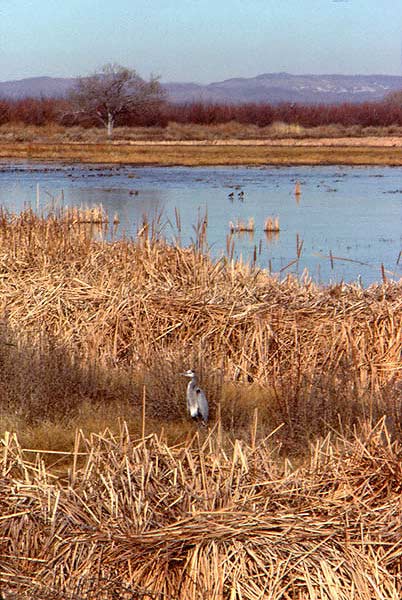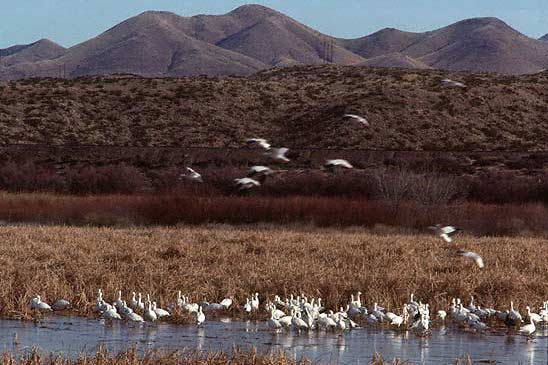
This morning I intended to get up early to spend the day with the birds at the Bosque del Apache. After I got out of the shower, I turned on the television to let the early news drone on while I dressed. The first thing that pushed itself into my conscious mind was that things were not normal today. Something big had happened. There was emergency news coverage on every channel. Within a few minutes I knew that a major earthquake had hit the Los Angeles area. This immediately changed my plans and pushed me into action. I started trying to get through to my daughter and her family in San Dimas, east of Pasadena along I-10. For the next two hours I dialed every few minutes, breaking this pattern only once to call Steve in Massachusetts to ask if he had been able to get through. I finally succeeded and talked to my daughter, Kathy, and to my grandaughter, Rebecca. They were all fine, if shaken, and, having lived in California (WWW servers) for several years, were well trained in the correct behavior in times of earthquake activity. Rebecca described waking up with the immediate understanding of what was happening. She grabbed her brother, Daniel, from his bed and dragged him under the door frame and held him there. Her mother had been working downstairs (she does this when she wakes up in the night!) and yelled for Rebecca immediately. She was answered by a young lady, very much in control of the situation, informing her mother that she had everything under control (including her brother, which is saying a lot)! Soon they were able to assess the damage to their home, which fortunately for them was only a few pictures askew on the walls and some things fallen from the shelves.
Later in the day they were able to get a feel for the damage that had been inflicted on the Los Angeles basin. It was very fortunate that this was a holiday, Martin Luther King Day, and that the earthquake occurred so early in the morning. The loss of life would have been much greater if the freeways had been bumper to bumper with the Monday morning traffic present on a normal schedule.
After I was assured that my California family was fine, I loaded my backpack and jacket into the van and left for the Bosque del Apache. I stopped at a convenience store to grab some yoghurt and a juice for breakfast and headed south on I-25. It is only about 15 miles to the San Antonio exit, then a short drive through the town and south again on New Mexico 1 to the refuge.
By this time the large birds have left the wetlands for their feeding grounds to the north. I stopped along the loop road to watch the many ducks and raptors and ate my breakfast, listening to the radio all the time for updates on the situation in Los Angeles. When I first visited the Bosque, the only ducks I could identify was a mallard, I thought. Actually, I was generous with myself in this assessment. As it turned out, I was also identifying the Northern Shoveler as a mallard, erroneously. That December, on my own and straight from a Christmas stay at Mule Shoe Ranch with my Tucson grandchildren, I spent hours carefully identifying the ducks at the Bosque and teaching myself to observe carefully and to note fine distinctions. I saw buffleheads, hooded mergansers, green winged teals and American coots. After two days of intense concentration, I was able to recognize many varieties of duck with little effort and recognized differences in behavior as well as markings. I considered this a major achievement. I had excellent practice in using techniques, such as patience and attention to detail, that are of extraordinary value in many other aspects of life and learned to appreciate another species in a way that can only be achieved by gaining familarity with them and closing the distance placed by circumstance between you and the "other." At the same time I was able to observe the incredible concentration of raptors who moved into this area, drawn by the staggering population of migrating birds. Besides the vultures, there were several bald eagles present, which I would occasionally see flying majestically down the length of the refuge. There were also sharpshinned hawks, redtailed hawks, Cooper's Hawks and Northern Harriers among others. The Canadian geese and Ring-necked pheasants were easy to identify. I saw Great Blue Herons fishing in the ditches.

There were kingfishers perched in dead trees overlooking the ditches, waiting to spot their lunch. The wading birds, American Avocets, Black Necked Stilts, Yellowlegs, . . . , I recorded them all on my birdlist. By the time I completed the lower loop, at an average speed of < 5 miles per hour, it was time for lunch. Fortunately, the town of San Antonio contains one of the most famous eateries in New Mexico, the Owl Cafe. I drove into San Antonio, late enough that the crowd had thinned, and enjoyed the specialty of the house, a green chili cheeseburger. Thus fueled, I returned to the refuge to continue around the northern loop. The southern loop, at this time of year, surrounds land that has been flooded to provide habitat for the hundreds of thousands of migrating waterbirds. The land within the northern loop is much drier. Except for a few places with shallow ponds, the water is mostly found in irrigation ditches and a few areas external to the loop road. The herons, waders and kingfishers are here, but the ducks are mostly left behind. There are a few fields inside of this loop road and some of the sandhill cranes have stayed behind to feed here.
In the dense grasses and shrubs along the road I exercise my powers of observation again to identify the small gray birds flitting and chirping in the underbrush. I find both white-throated and white-crowned sparrows and, of course, house sparrows.
At the northernmost end of the farm (north) loop are open fields where the grain has been harvested in a lossy manner in order to provide food for the enormous population of migrating birds that stop here. Observation platforms with telescopes are provided for visitors. Red-winged blackbirds are active in the cattails and reeds lining the irrigation ditches below the platforms. Flocks of sandhill cranes can be seen feeding in the fields. In one field hundreds of Ross Snow geese are feeding.

At times, for reasons imperceptible to a distant observer, they will rise into the air and appear to be unable to get organized and settle to the earth again. It is possible to watch these flocks for long periods of time, trying to discern the reasons for the sudden movements within the group. Also along the northern edge of the farm loop, but inside the loop, is the Bosque Trail. This trail winds through the bosque (woods) of tall old cottonwood trees. This trail provides a very different environment than the others through which I have traveled today. The huge old trees make excellent hiding places for owls to sleep during the day, invisible to prying eyes, while nestled against the bark of the cottonwoods. I saw a Cooper's hawk perched in one of the trees near the road, with a good view of the open fields. As with the kestrel in the Baboquiveri's, he became annoyed at being watched and flew off to find a more peaceful spot.
I continued around the loop road, seeing flocks of egrets and cormorants grouped in wide places and turns in the irrigation ditches. When I came to the end of this loop, I drove over to the visitor center where a different habitat is provided. The visitor center is on somewhat higher ground in a grove of cottonwoods and low shrubs. Here, in the hotter seasons, hummingbirds will be found zipping back and forth between the feeders and aggressively defending what they believe to be THEIR territory, this infinite supply of energy so necessary for their high speed movements. The visitor center offers exhibits on the migratory birds that use the bosque for a temporary home, especially the large sandhill and whooping cranes. They also draw attention to the role played by the mammal population drawn to this permanent source of water in the desert (note the very dry mountains in the background of both photographs!). Although the hours of the visitor center are quite short, especially in the summer, they do provide outdoor water fountains for the human migratory population too.
As the sun is getting low over the western hills, it is time to reenter the refuge and return to the north end of the loop road to watch the return of the large flocks for the night. A rapid trip around the one-way road took me back to the prime viewing area, rapidly becoming populated with people who wanted a chance to watch this massive homecoming.

Listening to the birds call to each other, we watched as the sun set and the cranes and geese returned to the water to settle in for the night. The cranes fly with their necks extended straight forward and their feet dangling behind. We stay until it is too dark to see the birds clearly. As we did last night, we slowly return to our cars and drive back to the exit road. Again we stop at the pool at the end of the loop, just before the exit, to watch the birds settle in for the night using our car headlights to illuminate the scene.
Back in Socorro, I find that
Lori arrived much earlier and was wondering where I was. She showed her
sister the departmental World
Wide Web pages at the VLA office building. We organized our thoughts
for a return to work tomorrow morning. It was time for a change of
direction. For the next four days we would concentrate on the reduction
and analysis of the data we had taken at the VLA in a search of the atomic
Hydrogen distribution within the L1641 dark cloud in Orion.
A story from the Atlantic Monthly in 1910, The Trail of the Plume-Hunter by William L. Finley, will provide good background reading on the necessity for the existence of preserves such as the Bosque del Apache.
Subscribe to American Indian Art Magazine
Arizona Highways
New Mexico Magazine
Bird Watchers Digest
Backyard Bird News
Wildbird
Recommend this website to a friend!
Books on Birds
Find more books on bird watching.
Find bird feeders and books on feeding birds.
Books on Earthquakes
Visit The Sonoran Desert 5000 square miles of silence.
![]() Return to
the Table of Contents
Return to
the Table of Contents